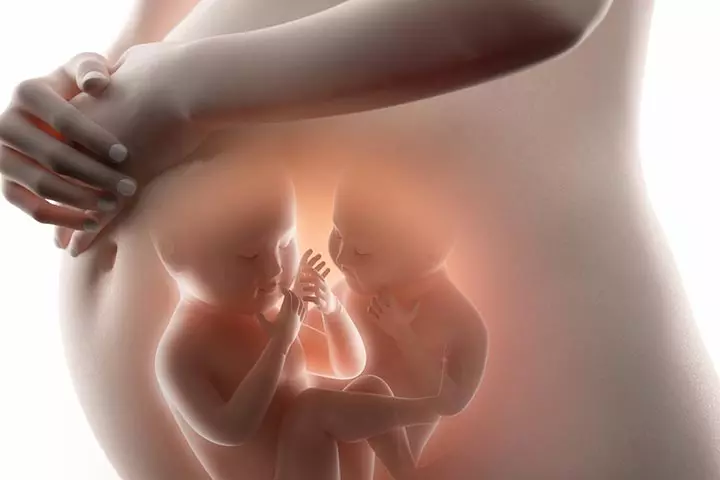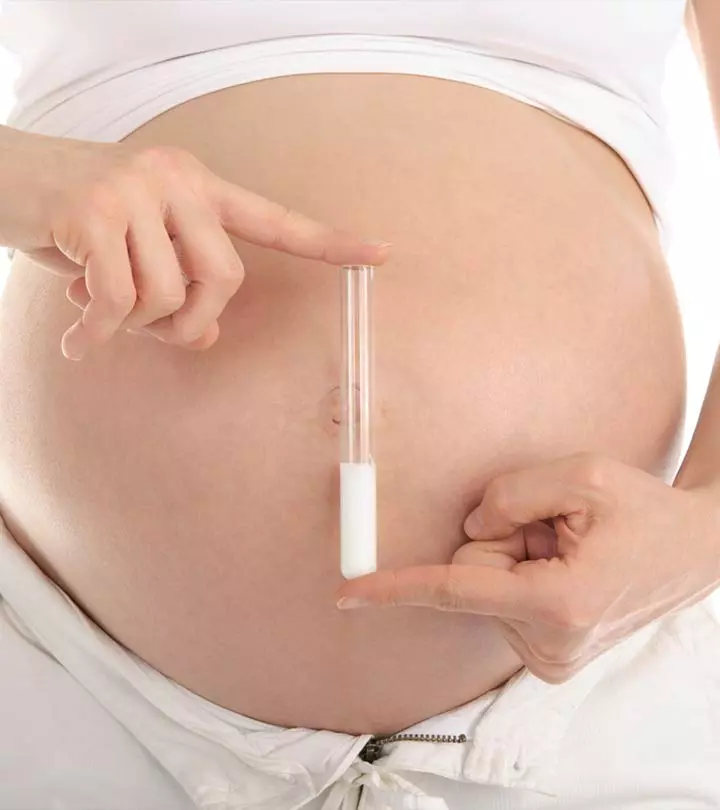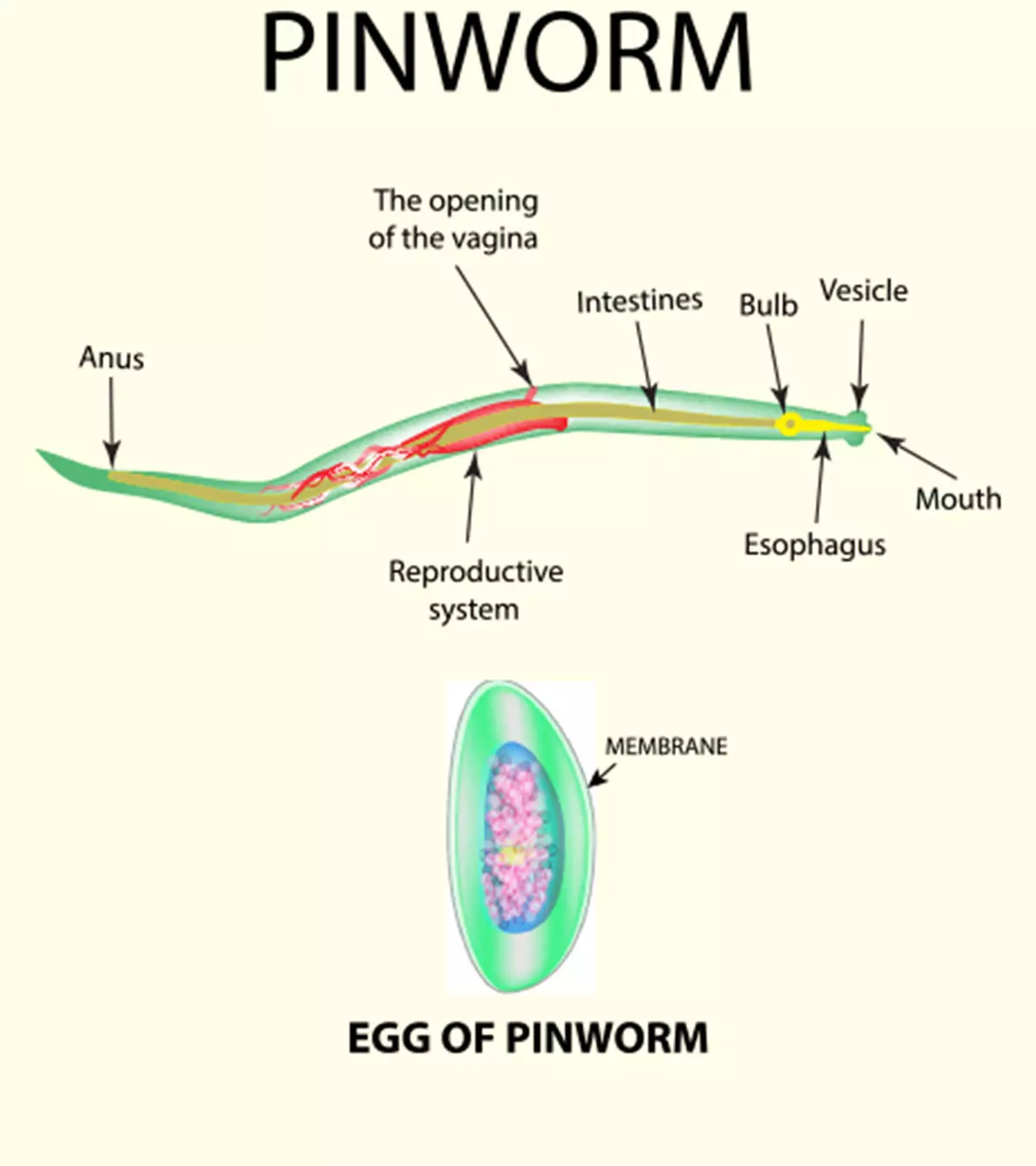
Image: Shutterstock
One out of four pregnant women experiences first trimester bleeding during pregnancy. Fortunately, despite bleeding in the initial days, many women have a healthy pregnancy and a healthy baby. Vaginal bleeding is when there is a discharge of blood from the vagina at any time during the pregnancy. It may occur between conception and delivery.
You should report vaginal bleeding during any stage of pregnancy to the OB/GYN. They would focus on identifying the underlying cause after running a few advanced tests. The following treatment or preventive measures depends on the diagnosis (1).
Read on to know the causes and treatment for vaginal bleeding during pregnancy.
Key Pointers
- Vaginal spotting is a mild blood discharge, whereas bleeding is intense.
- Implantation bleeding, molar or ectopic pregnancy, or miscarriage may cause bleeding during the first trimester.
- Appropriate rest, abstinence, no douching or tampons, etc., are recommended for treating vaginal bleeding in the first trimester.
Spotting Vs. Vaginal Bleeding
Spotting is a light, bloody discharge that happens now and then and is not heavy enough to cover a panty liner. Bleeding is a heavier blood flow, and one might need a pad or liner to prevent the clothes from getting soaked (2) (3). While spotting or bleeding is not uncommon, it is not always normal and needs medical attention.
Beth Harmon, a blogger, shares her experience with spotting while pregnant. She states, “I’m six weeks pregnant and spotting. The doctor said the spotting looked normal. He explained I likely got a tear in the capillaries of my uterine lining. It could have been when I sneezed. It would likely stop (i).” She further mentions that she has been seeing some spotting for the upcoming week and is feeling anxious about it. However, she explains that not worrying about the spotting for a while brings her relief and allows her to enjoy the beautiful pregnancy journey.
Causes Of First Trimester Bleeding
The following factors may lead to bleeding in the first trimester.
1. Implantation bleeding

Implantation occurs when the fertilized egg or embryo embeds itself in the uterine wall. It usually happens in the second half of your cycle. Some pregnant women experience implantation bleeding around the eighth week of pregnancy (4). If the placenta gets attached at the bottom of the uterus, painless vaginal bleeding is observed, often diagnosed as placenta previa. Certain risk or causative factors include fibroids in the uterine lining (uterine fibroids), placental abnormalities, and scarring of the endometrium.
Implantation bleeding is very light bleeding which is usually pink and at times brown. Some women know about it when they wipe themselves or on their underwear, and it is not enough to soak up a pad or your underwear. While it usually lasts only for a few days, for some women, it continues for a few more days.
2. Cervical polyp
Cervical polyps are a benign growth of connective tissue that may bleed when touched. Polyps are usually small and easy to see on examination and can be easily removed (3). According to the US National Institutes of Health (NIH), cervical polyps affect two to five percent of non-pregnant women and are typically uncommon in pregnancy.
3. Intercourse or physical examination
Some pregnant women may have spotting after intercourse or physical examination as the cervix is very tender and sensitive during pregnancy. Therefore, you should discontinue intercourse until the doctor permits you for the same to prevent any further irritation. However, it is important to note that intercourse does not cause miscarriage (5).
4. Multiple babies

Women carrying twins, triplets, or multiple babies may be at a higher risk of having vaginal bleeding in pregnancy. However, according to the American Society for Reproductive Medicine study, bleeding in the first trimester does not affect the live birth rate. However, it may be associated with an increased risk of low birth weight (6).
5. Ectopic pregnancy
An ectopic pregnancy is when the fertilized egg attaches itself to the outside of the uterus. It most often gets implanted somewhere in the fallopian tube. Apart from bleeding, unilateral abdominal pain, pain in the tip of the shoulder, low levels of hCG, and discomfort while peeing or pooping are other common symptoms of an ectopic pregnancy (4).
6. Molar pregnancy
A molar pregnancy is characterized by the growth of an abnormal tissue instead of an embryo. It is also known as a gestational trophoblastic disease (GTD). Abnormal heart tones, unusually high hCG levels, and the visibility of grape-like clusters on abdominal ultrasounds are other signs of molar pregnancy (5).
7. Subchorionic hemorrhage and subchorionic hematoma
It is the most common cause of vaginal bleeding in the first trimester. It happens when there is some bleeding under the chorion membranes that enclose the developing embryo in the uterus (7).
8. Infections
Infections of the pelvic cavity or urinary tract may also lead to vaginal bleeding (5). Additionally, a vaginal infection or yeast infection may also cause spotting or light bleeding.
9. Miscarriage

Bleeding could be a sign of miscarriage, but not every pregnancy with bleeding in the first trimester end up in a miscarriage. Approximately half of the women who bleed have a healthy pregnancy (5)
 Point to consider
Point to considerTreatment For First Trimester Vaginal Bleeding
For most women, the recommended treatment for vaginal bleeding is rest. However, your healthcare provider will decide the exact treatment plan after a thorough examination.
Depending on the underlying cause, the doctor may advise you on one or more of the following (2).
- Take time off work
- Stay off your feet
- Abstinence (No sexual intercourse)

- No douching (cleaning the insides of the vagina with a heavy flow of water)
- Not to use tampons
- For very heavy bleeding, hospitalization or surgical intervention might be advised
 Things to know
Things to knowWhen To Seek Medical Care
You must call or reach an emergency medical center in the following scenarios (2).
- Heavy bleeding
- Bleeding accompanied by abdominal pain or cramping
- Dizziness accompanying bleeding
- Pain in the pelvis or abdomen

If the bleeding is accompanied by the above symptoms it may indicate a threatened miscarriage or abortion. Hence, it is best to bring any episode of vaginal bleeding in pregnancy to your healthcare provider’s notice, even if the bleeding is mild and stops in some time.
Frequently Asked Questions
1. What to do if I have a previous history of miscarriage and am bleeding in the current pregnancy?
For women who have a history of miscarriage and are experiencing bleeding in the first trimester, progesterone supplements may be prescribed to prevent pregnancy loss.
Recent research has proven that progesterone therapy can be an effective therapy in preventing miscarriage. Progesterone helps in thickening the womb lining and supports the mother’s body to accept the growing baby. Progesterone may be given orally or vaginally (4).
2. What if I discharge something else along with or apart from the blood?
If you notice any other tissue coming out vaginally, put the discharge in a clean bag or jar. Make sure to immediately go to the emergency room and take the discharge along with you. The doctor will run blood tests and will check if you are still pregnant or not (2).
3. What does early miscarriage bleeding look like?
Early miscarriage bleeding may be either brownish or bright red. Brown discharge may look like coffee grounds and is usually old blood that has been in the uterus for a while, while the red bleeding may be bright in color and may or may not be accompanied by clots. Bleeding may also present as a gush of pinkish fluid from the vagina (6).
4. Is tranexamic acid safe in first-trimester pregnancy?
Research on a small number of women did not show any correlation between early pregnancy use of tranexamic acid and congenital abnormalities in the baby or any other pregnancy-associated complications (7).
First trimester bleeding is different from the commonly witnessed spotting. Bleeding during pregnancy may, at times, be the result of harmless reasons but can also indicate an abnormal pregnancy or a complication. So follow your doctor’s advice and trust the procedure. Do not panic; instead, consult your doctor to rule out any concerning issues and for adequate and prompt treatment. Timely medical intervention can help manage the situation.
Infographic: Potential Causes Of First Trimester Bleeding
Now that your pregnancy is confirmed and you’re set for your pregnancy journey, there will be moments of concern. Having vaginal bleeding or spotting during the first trimester is one such concern. Check out the infographic below to learn about possible causes of this occurrence, from common causes to serious conditions.

Illustration: Momjunction Design Team
Illustration: Causes Of First Trimester Bleeding (Spotting) & Treatment
__treatment_illustration.jpg.webp)
Image: Dall·E/MomJunction Design Team
You will undoubtedly be concerned if you experience any bleeding during your first trimester. Watch this video to gain some clarity on the situation and know when to worry and when to seek medical advice.
Personal Experience: Source
MomJunction articles include first-hand experiences to provide you with better insights through real-life narratives. Here are the sources of personal accounts referenced in this article.
i. I’m 6 weeks pregnant and spotting.https://medium.com/spacetoenjoy/im-6-weeks-pregnant-and-spotting-2867b38ab0e7
References
- Bleeding in early pregnancy
https://www.thewomens.org.au/health-information/pregnancy-and-birth/pregnancy-problems/early-pregnancy-problems/bleeding-in-early-pregnancy - Vaginal bleeding in early pregnancy
https://medlineplus.gov/ency/patientinstructions/000614.htm - I\’m Pregnant and Bleeding! What Should I Do?
https://www.stamfordhealth.org/healthflash-blog/maternal-child/pregnant-bleeding/ - Bleeding in pregnancy
https://www.tommys.org/pregnancy-information/pregnancy-symptom-checker/bleeding-pregnancy - Bleeding During Pregnancy
https://americanpregnancy.org/healthy-pregnancy/pregnancy-complications/bleeding-during-pregnancy/ - What are the signs of early miscarriage?
https://health.ucdavis.edu/obgyn/services/family-planning/early_miscarriage - Use Of Tranexamic Acid In Pregnancy.
https://www.medicinesinpregnancy.org/bumps/monographs/use-of-tranexamic-acid-in-pregnancy/ - Bleeding and spotting from the vagina during pregnancy.
https://www.marchofdimes.org/find-support/topics/pregnancy/bleeding-and-spotting-vagina-during-pregnancy - Vaginal bleeding during pregnancy:Causes and treatment.
https://my.clevelandclinic.org/health/symptoms/22044-bleeding-during-pregnancy
Community Experiences
Join the conversation and become a part of our nurturing community! Share your stories, experiences, and insights to connect with fellow parents.
Read full bio of Dr. Prachi Benara
Read full bio of Dr. Ritika Shah
Read full bio of Rebecca Malachi
Read full bio of Dr. Joyani Das





















